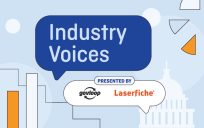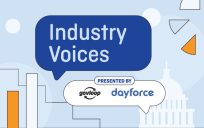Every year on the third Thursday in May, people around the world come together to celebrate Global Accessibility Awareness Day (GAAD), a day set aside to shine a spotlight on the critical importance of digital access and inclusion for persons with disabilities.
Established 12 years ago, GAAD serves to recognize the unique needs of the estimated one billion people worldwide (15% of the global population) who currently live with at least one disability.

Why Accessibility Matters
Government agencies are increasingly delivering services online, but many websites remain inaccessible to people who have disabilities.
- Imagine downloading a PDF document from a local government website that contains an application for an important social service such as transportation or food assistance. You open the PDF to start the application process but the entire document, which is a scanned image PDF, is blank.
- Imagine that a severe Category 5 hurricane emergency alert pops up on your television instructing you to call the number on the screen to locate your nearest shelter. You dial the number and there is only silence. The meteorologist on the screen also is highlighting your exact location but you can’t hear what she is saying because your television audio suddenly cut out.
- Imagine you are attempting to fill out a job application on a government website. A confusing animation carousel quickly and repeatedly replays explaining the complex application process. You are asked to drag and drop your resume into the form using your mouse. There is no “stop carousel” button to stop or pause the disappearing instructions, and since your mouse is broken, you can’t drag and drop your resume to the form.
The three situations above are examples of the types of common barriers faced by people who are blind, people who are hearing impaired, people who are cognitively impaired, and people who are dexterity impaired.
Accessibility considerations, such as ensuring that all PDFs are true text and not image scans of text, that TTY relay and closed-captioning services are provided for the hearing impaired, and that clear simple language instructions and alternative input controls are available to persons with cognitive and dexterity impairments, are key.
The theme of this year’s Global Awareness Accessibility Day, “Built Without Barriers,” emphasizes digital accessibility at the developer level, meaning at the front end of application development and not implemented as an “oh, by the way” afterthought.
Americans Support Organizations That Prioritize Diversity and Accessibility
A recent survey commissioned by National Industries for the Blind (NIB) shows that 68% of respondents are more likely to support a company that prioritizes diversity and 88% of Americans say companies should prioritize making workplaces more accessible to people who are blind or visually impaired.
And while the survey shows nearly nine out of 10 people in the U.S. agree workplace accessibility should be a priority, it also reveals that 56% still believe that doing so is difficult.
This shows us that:
1. Most Americans want more diverse, equitable, and inclusive workplaces.
2. Over half of the respondents think creating an accessible workplace is a daunting and expensive process.
The truth is, when addressing accessibility at the “build” level, creating accessible digital products is not difficult or expensive. In fact, doing so improves the user experience for everyone, not just for people with disabilities — hence the emphasis on this year’s GAAD “Built Without Barriers” theme.
How Pervasive Is the Accessibility Problem?
GAAD’s home page points to the results of a February 2024 survey conducted by WebAIM that provides a picture of the current state of website accessibility. The survey used WebAIM’s automated accessibility scanning tool to assess one million of today’s most influential home pages across the web.
The “WebAIM Million” study discovered:
- There was an average of 56.8 accessibility errors per home page examined, an increase of 13.6% over WebAIM’s 2023 report.
- 95.9 percent of the one million home pages contained WCAG 2.0 accessibility guideline failures.
- 81 percent of the one million home pages contained insufficient color contrast.
- 54.5 percent of the one million home pages contained missing alternative text descriptions of images.
- 48.6 percent were missing form input labels.
- 44.6 percent contained empty links.
- 28.2 percent contained empty buttons.
- 17.1 percent contained missing language.
The 2024 study found two concerning trends over the past several years:
- Home pages are increasingly using low-contrast text (up 13.7% from 2023), making today’s pages more difficult to read.
- Home pages are becoming more graphical: There was a 28% increase in the number of images on the one million home pages examined compared to 2023. Moreover, one out of four of the home page images did not contain any associated alternative text descriptions.
For a complete breakdown of the February 2024 “WebAIM Million” data, click here.
Call to Action
What the WebAIM study shows us is there still exists a crucial need for digital accessibility worldwide. On this Global Accessibility Awareness Day, let’s strive to move the needle beyond just “awareness for a day” and start establishing concrete accessibility protocols throughout our project life cycles.
If you are eager to start, assistance can be found on the following GAAD resource page: https://accessibility.day/resources.
To learn more about Global Accessibility Awareness Day and how it came into being, visit https://accessibility.day.
And, finally, if you would like to try out the same automated accessibility scanning tool used on the WebAIM Million project, you can download it as a Chrome, Firefox or Edge browser extension and begin assessing the accessibility of your agency’s internal and public facing web pages.
The free WAVE tool extension can be downloaded here.
With 95.9% of the world’s most influential homepages failing accessibility standards according to WebAIM, building inclusive government services is not just the right thing to do, it’s essential.
Doug Goist is the program manager, workforce development, at NSITE, the talent enterprise for National Industries for the Blind. A recognized leader in the field of technology accessibility, Doug has worked with the U.S. Department of Defense, the military services, federal agencies, and private sector partners. Through NSITE, Doug provides accessibility consulting for the private and public sectors and identifies career tracks, professional development, and educational resources for job seekers who are blind and visually impaired. https://www.linkedin.com/in/douglas-goist





Leave a Reply
You must be logged in to post a comment.